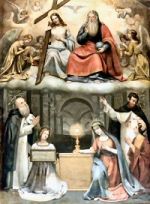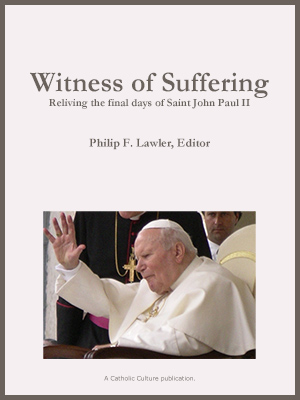The False Decretals
Anti-Catholic apologists often charge that Catholic doctrines regarding the primacy and infallibility of the bishop of Rome are founded upon a set of documents forged in the ninth century, known as the "False Decretals" or the "Pseudo-Isidorian Decretals," which purport to be written by early popes. It is alleged that Roman bishops relied on these forgeries to establish their authority and that without these forgeries popes never could have "become" infallible.
Dave Hunt devotes a whole chapter of A Woman Rides the Beast to Rome's "Fraud and Fabricated History." According to Hunt, the popes "labored mightily to satisfy their lust for power and pleasure and wealth." Not being able to find justification for these powers in Scripture or the Church Fathers, rewrite history by manufacturing allegedly historical documents." Another anti-Catholic apologist, William Webster, says in The Church of Rome and the Bar of History that Rome was the "first to use" the False Decretals and that they "completely revolutionized the primitive government of the Church." Similar claims regarding the False Decretals are made by former Catholic and ex-priest Peter de Rosa in Vicars of Christ.
Anti-Catholic apologists argue that the False Decretals provided the scriptural and historical precedents upon which papal doctrines are founded. Examples from the False Decretals suffice to illustrate how they appear to support the anti-Catholic argument. The so-called First Epistle of Zephyrinus applies the words "Whatsoever thou shalt bind on earth shall be bound in heaven, and whatsoever thou shalt loose on earth shall be loosed in heaven" (Matt. 16:19) to Peter and to his successors in the See of Rome. Bishops are said to be judged by the pope "and by no other." The equally fraudulent First Epistle of Pope Callistus calls the Roman Church the "mother of all Churches" and "head" of the Church and declares that anything done contrary to the Roman Church "cannot on any account be permitted to be held valid."
J. H. Ignaz von Dollinger, the nineteenth-century historian who defected from the Church after the promulgation of the dogma of papal infallibility, says it is "with perfect consistency that Pseudo-Isidore makes his early popes say: 'The Roman Church remains to the end free from the stain of heresy."' Dollinger claims that prior to the False Decretals "no serious attempt was made anywhere to introduce the neo-Roman theory of infallibility" and that "the popes did not dream of laying claim to such a privilege." Upon such forged letters, or so the anti-Catholic alleges, the papacy is built.
That the False Decretals contain material that supports papal claims does not prove that the bishops of Rome played any part in their manufacture. Forgers often mix actual events, widely-known facts, and personalities into their work in order to improve a document's credibility. One cannot presume the subject matter of a forged document easily or necessarily reveals the identity or the agenda of its true author. The spurious "Arabic Canons" of Nicaea, which call the pope the "head and prince of all patriarchs," are more explicitly pro-primacy than are the genuine canons of the council of Nicaea. These spurious canons were written not in the West but in the East. If this fact had not been known widely, anti-Catholic apologists might have added the Arabic Canons to their list of alleged Roman forgeries.
By Webster's reckoning, the False Decretals were written in 845. Pope Nicholas I (858-867), the first pope to quote them, did not begin his reign until thirteen years and three pontificates later. These facts suggest the False Decretals had been in circulation and had obtained credibility before Nicholas I used them. If they had been intended to advance Roman claims of authority, one would expect that they would have made their Roman debut centuries earlier than they did. Regardless, the long-held opinion of scholars, including Dollinger—who is the main source for Hunt, Webster, and De Rosa on this matter—is that the False Decretals were written in France, not Rome.
More devastating to the anti-Catholic apologist's argument is that Dollinger admits that the goal of the forger was not the extension of papal authority. Rather, he says, "The immediate object of the compiler of this forgery was to protect bishops against their metropolitans and other authorities, so as to secure absolute impunity and the exclusion of all influence of the secular power." Dollinger asserts this object was to be gained through "an immense extension of the papal power."
In essence, he argues that Roman primacy and infallibility were created by the forger to be the means by which his real goal—the protection of local bishops—could be achieved. But this argument is unreasonable. The concocting of such a grand, elaborate, and "new" theory of papal powers to achieve the relatively modest end of protecting local bishops would create more difficulties for a forged document's credibility than it could hope to solve. What seems more probable is that the forger appealed to an authority his audience already knew and accepted and by means of this acceptance hoped to advance his agenda. Such an appeal would not be the first time a forger had attempted to use the prestige and authority of the Roman see to his advantage. For example, the sixth ecumenical council, Constantinople III (680), examined heretical letters said to have been written by Pope Vigilius, but it rejected them as frauds. The more serious accusation is that the forgeries brought about a "revolution" in the government of the Church. While the anti-Catholic charge appears damning at first glance, it must be remembered the Roman claims were well-established before the False Decretals were penned in the ninth century. Roman bishops long had applied verses of Scripture to their office. For example, papal legates at the Council of Ephesus (431) refer to the pope as the successor of Peter and as having the powers to bind and loose (Matt. 16:19), while Pope Hormisdas, in 517, applies Matthew 16:18—where Peter is declared "rock"—to the Apostolic See. Although the False Decretals describe the Roman Church as "head," numerous genuine documents that predate these forgeries explicitly declare as much. The records of the ecumenical councils of Ephesus, Chalcedon (451), Constantinople III, and Nicaea II (787) contain many references to the pope or the Apostolic See as "father," "head of all Churches," "archbishop of all the Churches," "spiritual mother," "sacred head," and so forth.
It was no ninth-century innovation to claim that anything done against the will of the Apostolic See was invalid. Fifth-century historians Sozomen and Socrates, in separate histories of the fourth-century Church, record in similar words that "an ecclesiastical canon commands that the Churches shall not make any ordinances against the opinion of the bishop of Rome." Peter Chrysologus, bishop of Ravenna, declares in his Letter to Eutyches (449) that cases of faith cannot be tried "without the consent of the bishop of Rome." At the Council of Chalcedon, papal legates—without opposition—declare the holding of a council without the pope's authority to be a "thing which had never taken place nor can take place." The Council of Ephesus declares itself "compelled" by the canons and by the decision of Pope Celestine to depose the heretic Nestorius, Patriarch of Constantinople. The pope was recognized in both East and West as having the authority to hear appeals from bishops, to depose them, and to restore them to their sees, as proved by the course of history and by the canons of the Council of Sardica (343).
While infallibility may be inferred from some of the genuine documents cited, more explicit affirmations of it may be found in other places. For example, in 517 the Eastern bishops assented to and signed the formula of Pope Hormisdas, which states in part: "The first condition of salvation is to keep the norm of the true faith and in no way to deviate from the established doctrine of the Fathers. For it is impossible that the words of our Lord Jesus Christ who said, 'Thou are Peter, and upon this rock I will build my Church' [Matt 16:18], should not be verified. And their truth has been proved by the course of history, for in the Apostolic See the Catholic religion has always been kept unsullied."
In a letter from Pope Agatho, accepted by Constantinople III, the Pope says the Roman Church "has never erred," has never yielded to "heretical innovations," and "remains undefiled unto the end." Agatho links this claim directly to the "divine promise" found in Luke 22:32, where the Lord prays that Peter's faith would never fail. Declarations that the Apostolic See "has been kept unsullied" are claims of papal infallibility.
In short, there is no reason to suspect the papacy to be the forgery factory conjured up in the minds of anti-Catholic apologists. If many, including popes, presumed the veracity of the False Decretals for a time, it was because the documents in many respects corresponded to the already long-accepted reality of the primacy and infallibility of the popes. Furthermore, no doctrinal error may be inferred from the fact that False Decretals were quoted by popes, since papal infallibility applies to definitions on faith and morals, not to judgments about the authenticity of documents. The important point is that none of the forgeries served as the basis for a single doctrine regarding the papacy. The doctrines came first, the forgeries long centuries later.
• Steven O'Reilly freelances from Snellville, Georgia.
© This Rock, Catholic Answers, P.O. Box 17490, San Diego, CA 92177, (619) 541-1131.
This item 1059 digitally provided courtesy of CatholicCulture.org






